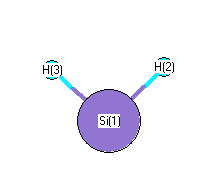.
| squib |
reference |
DOI |
| 1979HUB/HER |
Huber, K.P.; Herzberg, G., Molecular Spectra and Molecular Structure. IV. Constants of Diatomic Molecules, Van Nostrand Reinhold Co., 1979 |
10.1007/978-1-4757-0961-2 |
| 1998Gup/Pra:1607 |
Gupte, Prasad, Ground State Geometries and Vibrational Spectra of Small Hyrdogenated Silicon Clusters Using Nonorthogonal Tight-binding Molecular Dynamics, Inter. J. of Mod. Phys. B, Vol. 12, #15, pgs. 1607-1622 |
10.1142/S0217979298000880 |
| 1999Hir/Ish:4254 |
Hirota, E.; Ishikawa, H. "The vibrational spectrum and molecular constants of silicon dihydride SiH2 in the ground electronic state." Journal of Chemical Physics. 110, 4254-4257 (1999) |
10.1063/1.478308 |
| Gurvich |
Gurvich, L.V.; Veyts, I. V.; Alcock, C. B., Thermodynamic Properties of Individual Substances, Fouth Edition, Hemisphere Pub. Co., New York, 1989 |
|
| VEEL5 |
M.E. Jacox, Vibrational and Electronic Energy Levels of Polyatomic Transient Molecules, J. Phys. Chem.Ref. Data, Monograph 3 (1994) (updated data in NIST Chemistry Webbook - http://webbook.nist.gov/chemistry/ |
|
| webbook |
NIST Chemistry Webbook (http://webbook.nist.gov/chemistry) |
10.18434/T4D303 |











